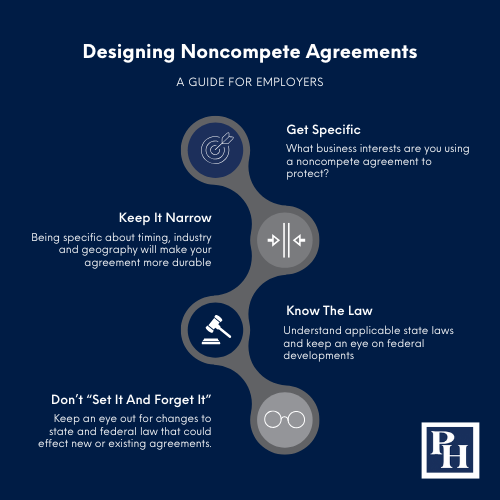Noncompetition, or noncompete, agreements have been a mainstay of American business for decades. But as lawmakers and regulators subject them to increasing scrutiny, businesses may need to look elsewhere to protect their interests.
At its core, a noncompete agreement is a legally binding arrangement in which employees agree not to work for direct competitors or set up a business in direct competition with their former employer once they depart a position. Companies often require noncompete agreements for sales positions, but they’re also common for researchers, medical professionals and workers in the tech sector, among others. Noncompetes are not the exclusive domain of employment contracts either, even if that is their most common association. They can appear in contracts for sales of a business or consulting arrangements.
The specific terms of these contracts vary, but in most cases, the agreements are bound by a period of time after the employee’s departure, a geographic area surrounding the business, or both. Even before the recent scrutiny aimed at noncompetes, employers who have tried to create overly broad contracts have risked losing legal challenges from former employees who found it difficult to secure new work. Overly harsh penalties for workers who break their noncompete agreements have also created openings for challenging the arrangements. It has long been a best practice to create a noncompete only as broad as necessary to protect the business. The broader the noncompete, generally the weaker it is when challenged.
Noncompetes are governed by state law. Today a growing number of states are moving to restrict them or ban them outright. At this writing, four states (California, Minnesota, North Dakota and Oklahoma) do not allow noncompetes in employment contracts at all. Some of them, however, do have exceptions for these clauses appearing in a business sale or dissolution agreement for a partnership.
In addition, 33 states and the District of Columbia have passed laws restricting how employers may use noncompete agreements. Some states institute an income threshold, below which the agreements are not permitted. Others ban noncompetes for specific industries, frequently including health care. Many states also differentiate between noncompetes offered to employees and to independent contractors.
In the near future, more states may join the four that have already imposed outright bans. Legislators in Maine and Rhode Island banned noncompetes in 2024, though those states’ governors ultimately vetoed the bans. New York’s Gov. Kathy Hochul vetoed similar legislation last year, remarking that she hoped lawmakers would modify it. Instead, the veto stood, though it is possible New York’s legislature will take another run at a ban this year. If so, it would join potential bans under discussion in the legislatures of Connecticut, Missouri, New Hampshire, New Jersey, South Carolina and Washington state.
It is not clear which, if any, of these bans will ultimately make it into law. But the number of states discussing the possibility illustrates that many lawmakers have grown skeptical about the use of noncompete agreements.
The FTC Ban On Noncompetes
In this atmosphere, the Federal Trade Commission attempted to ban noncompete agreements nationwide last April. In a press release, then-FTC Chair Lina M. Khan said: “Noncompete clauses keep wages low, suppress new ideas, and rob the American economy of dynamism, including from the more than 8,500 new startups that would be created a year once noncompetes are banned.”
The rule would have also invalidated most existing noncompete agreements, though certain contracts for senior executives were permitted to remain in force. In addition, it would have permitted narrow carve-outs going forward for noncompete clauses in business sales and in contracts between franchisors and franchisees. The FTC made the argument that other instruments, such as nondisclosure agreements and laws governing trade secrets, would offer employers sufficient protection in most situations.
Almost immediately, the rule faced multiple legal challenges. The first was Ryan LLC v. Federal Trade Commission, a case in Texas. It was followed by cases in Pennsylvania (ATS Tree Services, LLC v. FTC) and Florida (Properties of the Villages, Inc. v. FTC).
In Ryan, the first decision to be handed down, the U.S. District Court for the Northern District of Texas found that the FTC’s noncompete ban exceeded the commission’s authority. The court granted the plaintiffs’ motion for summary judgment and set the rule aside. This decision hinged on whether the FTC had overstepped its authority in making the rule in the first place. As such, it did not discuss whether noncompetes were lawful on their own terms.
Unsurprisingly, the FTC appealed the Ryan ruling, as well as the ruling in Properties of the Villages, which came to a similar conclusion. (ATS Tree Services found that the FTC had acted appropriately.) For now, state law continues to control noncompete clause enforcement, as it did prior to the FTC’s rulemaking.
The National Labor Relations Board On Noncompetes
The FTC’s rule followed the lead not only of several states, but also of the National Labor Relations Board. In May 2023, the NLRB’s general counsel, Jennifer Abruzzo, released a memo claiming that noncompete provisions in employment agreements violate the National Labor Relations Act. More than a year later, in October 2024, Abruzzo issued another memo that set out a framework for analyzing so-called “stay-or-pay” provisions. These provisions stipulate that employees must pay their employer if they depart within a certain period (for example, paying back a sign-on bonus). This 2024 memo also set out new remedies for employers found to be proffering or enforcing unlawful employment agreements, potentially including noncompetes.
Neither of the NLRB memos are legally binding on their own terms. They did, however, signal an NLRB that was ready and willing to subject noncompete agreements to scrutiny. Critics claimed the memos were aggressive, while supporters took encouragement from Abruzzo’s positions. Regardless, the NLRB has indeed taken action against employers whose noncompete agreements have, in the Board’s view, violated the National Labor Relations Act.
What Comes Next For Noncompetes
As my colleagues and I have written before, no one can see the future. However, a look at the present can suggest the state of noncompetes, at least in the short term.
President Donald Trump has appointed Andrew Ferguson as the new chairman of the FTC, replacing Khan. Ferguson was already a commissioner, so the appointment did not require Senate approval. Khan has told FTC staff that she plans to resign as a member of the FTC. Trump’s proposed replacement on the committee, Mark Meador, will require Senate approval, but there are no indications that he will not be confirmed as of this writing.
The change to the composition of the FTC makes it likely that the commission will either abandon its appeals in the cases I’ve discussed or rescind the rule banning noncompetes outright. Ferguson issued a strong dissent when the FTC originally issued the rule in question, arguing that the rule “wildly exceeded” the FTC’s authority. In the less-likely event that the FTC opts to continue the appeals process, the question could eventually make its way to the Supreme Court.
Like the FTC, the NLRB faces changes in the new administration. Trump has appointed Marvin Kaplan as acting chair of the Board. The board had two existing vacancies to fill and Trump's dismissal of board member Gwynne Wilcox created a third, though Wilcox has said she will challenge this dismissal in court. The president also fired general counsel Abruzzo, as former President Joe Biden did to her predecessor when he took office. While we will have to wait and see what the newly composed NLRB will prioritize, the noncompete memos could be repealed. At a minimum, employers may face less NLRB scrutiny of noncompete agreements for the next few years.
Even with a new administration in Washington, many state lawmakers may continue to look at noncompete agreements with a critical eye. This raises the question: How should employers approach noncompetes in this environment?

First, it is critical to get specific about what business interests you are using noncompete agreements to protect. Can other approaches, such as nondisclosure agreements, nonsolicitation agreements, or other legal arrangements accomplish what you want? Note, however, that some states have also turned scrutiny on nonsolicitation agreements, so be sure you are up to date on the laws in places you do business (and upcoming legislation your lawmakers are evaluating).
Second, bear in mind that narrow agreements are more likely to stand up under scrutiny. Be as specific as is practical about timing, industry (including the definition of a “competitor”), geographic location and other limits on the agreement’s application. You don’t want to punish a well-intentioned former employee by making it impossible for them to work elsewhere, regardless of how hard they try to separate themselves from your client or customer pool.
Finally, realize that noncompete agreements are not a “set it and forget it” project. Make sure your human resources and legal departments, if you have them, stay continually up to date on state and federal developments that could impact noncompete agreements if you choose to institute them. In most states you can still enter into these arrangements if they’re properly constructed, but you may want to give some thought to alternatives if the legal landscape changes or if you want to expand into states that do not permit these arrangements.
Noncompetes may hang on in a limited form, or they may be destined to vanish from American working life state by state. Since their future is unclear, treat noncompetes as one tool among many when working to protect your business.













